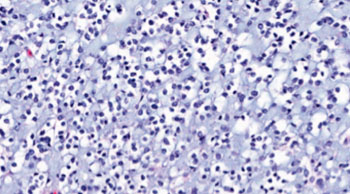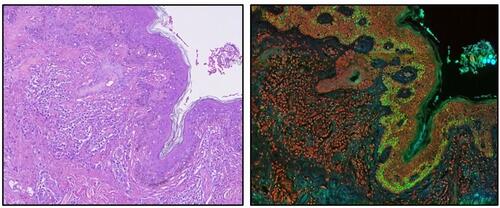Panel of Genetic Biomarkers Separates Brain Tumors into Five Distinct Classes
By LabMedica International staff writers
Posted on 22 Jun 2015
A panel of three genetic biomarkers has been identified that can differentiate brain tumors (gliomas) into five principal groups.Posted on 22 Jun 2015
Currently, malignant gliomas are classified based on the appearance of biopsy samples under the microscope, and their grade is assigned according to degree of aggressiveness, with grade II being the least aggressive and grade IV the most.

Image: Highly magnified view of brain tumor (glioma) cells (Photo courtesy of the University of California, San Francisco).
Investigators at the University of California, San Francisco (USA) and the Mayo Clinic (Rochester, MN, USA) now offer a more precise mechanism for glioma classification. They found that a panel of three biomarker mutations could separate 95% of gliomas into one of five distinct groups. The biomarkers are (1) mutations in the TERT (telomerase reverse transcriptase) promoter gene, (2) mutations in the IDH (isocitrate dehydrogenase) gene, or (3) co-deletion of chromosome arms 1p and 19q (1p/19q co-deletion).
Telomerase is a ribonucleoprotein polymerase that maintains telomere ends by addition of the telomere repeat TTAGGG. The TERT (telomerase reverse transcriptase) enzyme consists of a protein component with reverse transcriptase activity and an RNA component, which serves as a template for the telomere repeat. Deregulation of telomerase expression in somatic cells may be involved in their transformation into cancer cells. Studies in mice suggest that telomerase also participates in chromosomal repair, since de novo synthesis of telomere repeats may occur at double-stranded breaks.
Specific mutations in the isocitrate dehydrogenase gene (IDH1) have been found in several brain tumors including astrocytoma, oligodendroglioma, and glioblastoma multiforme, with mutations found in nearly all cases of secondary glioblastomas, which develop from lower-grade gliomas, but rarely in primary high-grade glioblastoma multiforme. Patients whose tumor had an IDH1 mutation had longer survival.
In the current study, the investigators analyzed genetic and clinical data from 1,087 malignant glioma patients and 11,590 healthy controls. They found that among grade II and III tumors, 29% were “triple positive,” showing all three markers. Patients with these tumors had a median survival time of 13.1 years. About 5% of patients had tumors with both TERT and IDH mutations, and had a median survival time similar to the triple positive patients. Nearly 45% of patients had tumors with only the IDH mutation and had a median survival time of 8.9 years. Approximately 7% of patients had triple negative tumors with none of the mutations, and these individuals had a median survival time of 6.2 years. The approximately 10% of patients whose tumors had only the TERT mutation were associated with the shortest median survival time – 1.9 years.
“Unfortunately, classifying a tumor only by appearance and grade has not provided sufficient information about the way the tumor is likely to behave, how it will respond to treatment or the patient’s likely survival time,” said contributing author Dr. Margaret R. Wrensch, professor of neurological surgery, epidemiology, and biostatistics at the University of California, San Francisco. “These markers will potentially allow us to predict the course of gliomas more accurately, treat them more effectively, and identify more clearly what causes them in the first place.”
A paper describing the new classification protocol was published in the June 10, 2015, online edition of the New England Journal of Medicine (NEJM).
Related Links:
University of California, San Francisco
Mayo Clinic













